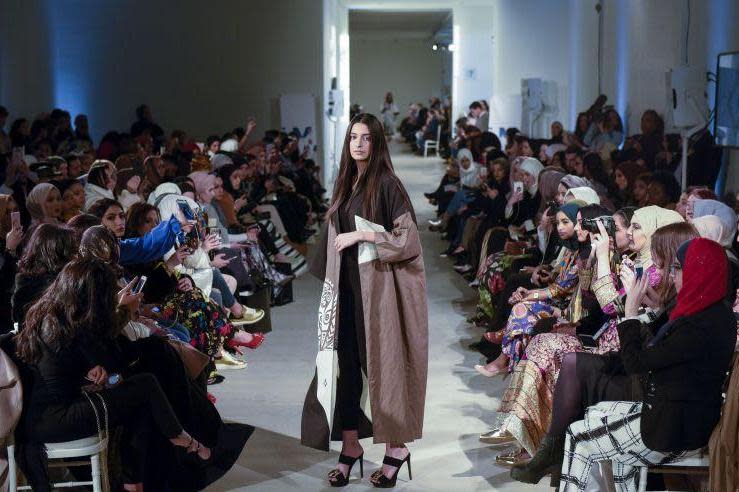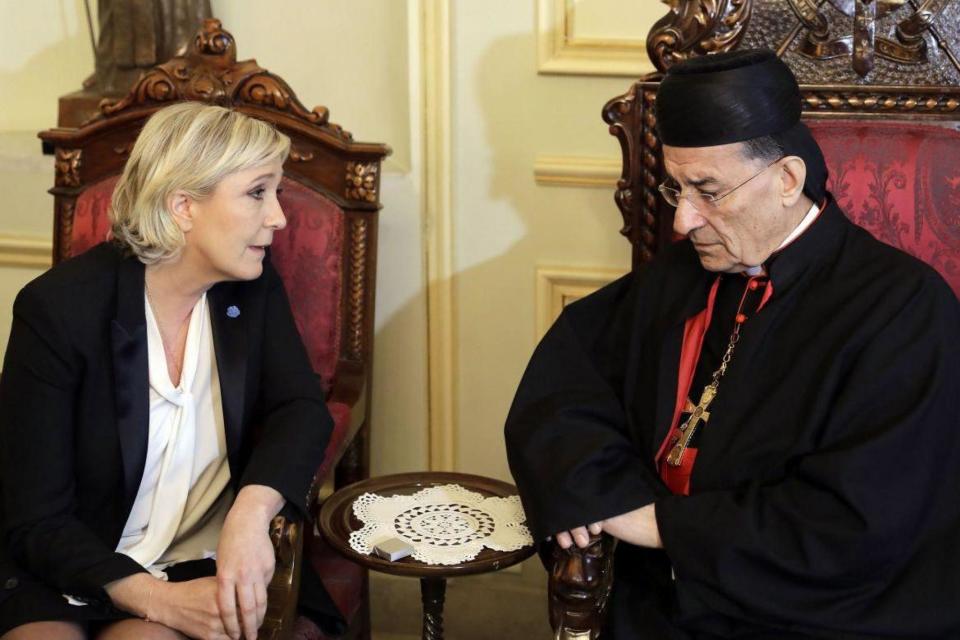How the hijab became this week's biggest talking point: from Lindsay Lohan to London Modest Fashion Week

Of all the platforms on which the headscarf debate seemed likely to rear its head, Lindsay Lohan’s transatlantic pit stop at Heathrow Airport was a surprising flashpoint. The Mean Girls star was flying from Turkey to New York via London when she was asked by immigration staff to remove a scarf she donned “out of respect” while working with refugees. The actress later claimed she had been “racially profiled” for the “first time in my life”.
Lohan’s travails were soon overtaken in a week in which headscarves were at the centre of political statements. Over the weekend, a delegation from Sweden’s self-proclaimed feminist government visited Iran, only to be rounded on internationally after female ministers on the trip were photographed wearing headscarves. On Tuesday, Marine Le Pen, leader of France’s Front National party, walked away from a meeting in Beirut with the Muslim cleric Sheikh Abdel-Latif Derian after refusing to cover her head.
“The hijab has become a symbol around the world of how Muslim women are defined,” says journalist Shaista Aziz, founder of the anti-racism digital platform The Everyday Bigotry Project. “If a woman chooses to wear or not to wear a hijab, it should be a matter for only her. And note the word choice.”
The Politics
For a flap of fabric, the headscarf has had a surprisingly dominant role in politics for years — especially in France, which has the largest number of Muslims in Western Europe and which bans hijabs in the public service and for school pupils. But this week the politicisation of the veil took centre stage — with France again the focus as Marine Le Pen cancelled a meeting with Lebanon’s Grand Mufti, the top cleric for Sunni Muslims, after refusing to wear a headscarf for the encounter.
“Pass on my considerations [to the cleric] but I will not veil myself,” Le Pen declared. Whether or not her refusal was a publicity stunt, it has created one of the few occasions when some feminists found themselves celebrating a move by the Right-wing Front National.
Le Pen has gained two million more female voters since her last presidential bid in 2012. Her move — and that of Turkey, which repealed a rule that forced women in the military to wear a hijab — went down better than the Swedish politicians, who were last week mocked on social media for wearing headscarves in Iran.

One viral photo showed members of the delegation in Tehran donning Islamic headscarves with the caption “Walk of shame: Women of Sweden’s ‘first feminist government in the world’ don hijab as they walk past Iran’s [President] Rouhani”.
Then there was Iranian chess champion Dorsa Derakhshani, 18, who was kicked off her country’s national team for removing the headscarf required in her homeland to go bare-headed for a tournament in Gibraltar. “Our national interests have priority over everything,” the head of the Iranian Chess Federation declared. But that’s unlikely to be checkmate in the hijab’s long-running use as a political pawn.

The Brands
When L’Oréal Paris yesterday unleashed its “All Worth It” campaign with The Prince’s Trust, everyone was talking about Cheryl’s pregnant bump and Helen Mirren’s “incredible self- doubt”. And the presence of headscarf-wearing YouTuber Amena Kin? That went largely undiscussed.
It’s a sign of how speedily brands are now embracing “hijabis” — women wearing hijabs: campaigns by mega-brands including Apple, Uniqlo, Dolce & Gabbana and Danone. L’Oréal Paris wasn’t even the only beauty brand to feature a hijab-wearing model in its latest campaign: so did Lancôme, with make-up artist Sumra Khan one of the faces of its Teint Idole Ultra Wear foundation. Big business now sees the lucre in Generation M, the young, affluent millennial Muslims who are big spenders.
“Over the past 18-24 months we’ve seen a huge turning point in brands’ recognition of young Muslims who believe that being faithful and modern go hand-in-hand,” says Shelina Janmohamed, vice-president of Ogilvy Noor, an international consulting and marketing agency focusing on businesses that want to reach out to Muslims. “Generation M is finally being recognised on the high street as consumers just like everyone else — which is what they want, to be able to go and buy clothes, food or any other product, but one that is tailored for them. Why, they wonder, does everyone want to talk burkinis all the time?”
A post shared by L'Oréal Paris Makeup (@lorealmakeup) on Feb 23, 2017 at 1:17am PST
For the profit-pursuing brand manager, using “hijabis” in ads makes commercial sense: the “modest” fashion industry alone is estimated to be worth $484 billion, while two-thirds of Generation M are under 30 and with a global spend of some $2.6 trillion.
That’s one reason why Mariah Idrissi, the Wembley Park-born model who was scouted while working in a shop in Westfield and became the first hijab-wearing woman to be involved in a major campaign for H&M, has seen bookings rocket in recent months. “Some brands are simply looking for the ‘token’ hijabi to show diversity, and some genuinely want to broaden their market or appeal to an already active one,” the 24-year-old adds.
It’s refreshing, says Idrissi, to see the veil talked about in non “political” terms. “From the start, one of my motivations as a model was to change conversations on the hijab from being so heavily focused on politics and negativity into the other great things Muslim women are achieving. Like any other woman, we share the same interests and hobbies — using a woman in a hijab for marketing shouldn’t be something so difficult for people to digest.”

The Fashion
In London, the UK’s first “modest fashion week” took place over two days at the Saatchi Gallery in front of 3,000 people, mostly young Muslim women, where hijabs, burkinis and kimonos came to the catwalk. Launched by online fashion marketplace Haute Elan, the event was intended to showcase fashion more sensitive to faiths — in fact, anyone who prefers a more demure look. Leather caps were paired with hijabs, while statement It-bags were matched with floor-length, nude-coloured kimonos.
“Modest fashion is not just for us, it’s something for everyone,” says Idrissi. “You don’t have to be Jewish or Muslim to be modest — every woman can choose to dress so.” Idrissi says the high street has yet to catch up to the demands for modest fashion, “especially evening wear”, although this year Debenhams will become the first major UK retailer to meet the gap, teaming up with London-based brand Aab to produce a line of modestclothing.
“We started Aab almost a decade ago as a label that redefined modest fashion and one that caters for everyday modern wardrobe staples that are thoughtfully designed with the highest quality,” says Nazmin Alim, founder and creative director at Aab. “The partnership with Debenhams opens up some very exciting opportunities for us.”
While modest fashion goes low, it also goes high. Max Mara, the Italian fashion powerhouse, unveiled its latest collection in Milan yesterday, with Gigi Hadid modelling modest, monochromatic trouser suits and sheer, Scandinavian-inspired roll-neck sweaters. Alongside Hadid, Max Mara called on the services of hijab-wearing model Halima Aden, a first for the fashion house. “Max Mara empowers women; from all geographical areas, all creeds, all philosophies. Halima is ambitious, confident and beautiful,” says Ian Griffiths, Max Mara’s creative director.
“Hijab isn’t fashion but it can tie into it,” says Idrissi. “The same girls who go to school with non-Muslim friends don’t feel so different any more. Everyone can be included.”
Follow Samuel Fishwick: @fish_o_wick
Follow Lucy Tobin: @lucytobin

 Yahoo News
Yahoo News 